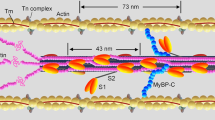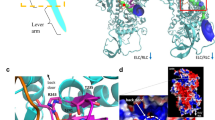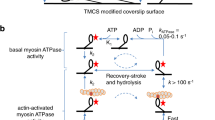Abstract
THE present view of the molecular mechanism of muscle contraction1 does not explain why myosin has two structurally similar globular heads2. Each of these heads can interact with actin and with ATP, and each seems to hydrolyse ATP at about the same rate3. To investigate possible functional differences between the two heads of myosin, we have compared the rates of intermediate oxygen exchange4–6 catalysed by heavy meromyosin (HMM), which has two heads, and subfragment 1(S1), which has one head, at different levels of actin activation. This oxygen exchange occurs between water and the γ-phosphoryl groups of two enzyme–nucleoside phosphate intermediates along the pathway of coupled ATP hydrolysis7. Thus, measurements of oxygen exchange can be used to probe the kinetics of intermediate steps in the hydrolytic and contractile mechanism. Any difference in the rate of oxygen exchange indicates either a difference in the lifetimes of the exchanging intermediates, or in the kinetic constants of the exchange reaction itself4–6,8.
This is a preview of subscription content, access via your institution
Access options
Subscribe to this journal
Receive 51 print issues and online access
$199.00 per year
only $3.90 per issue
Buy this article
- Purchase on Springer Link
- Instant access to full article PDF
Prices may be subject to local taxes which are calculated during checkout
Similar content being viewed by others
References
Taylor, E. W. A. Rev. Biochem. 41, 577–616 (1972).
Margossian, S. S. & Lowey, S. J. molec. Biol. 74, 313–330 (1973).
Moos, C., Cold Spring Harb. Symp. quant. Biol. 37, 137–143 (1972).
Levy, H. M. & Koshland, D. E., Jr J. biol. Chem. 234, 1102–1107 (1959).
Levy, H. M., Ryan, E. M., Springhorn, S. S. & Koshland, D. E., Jr J. biol. Chem., 237, PC1730 (1962).
Levy, H. M., Sharon, N., Lindemann, E. & Koshland, D. E., Jr J. biol. Chem. 235, 2628 (1962).
Bagshaw, C. R., Trentham, D. R., Wolcott, R. G. & Boyer, P. D. Proc. natn. Acad. Sci. U.S.A. 72, 2592–2596 (1975).
Wolcott, R. G. & Boyer, P. D. J. supramolec. Struct. 3, 154–161 (1975).
Yount, R. G. & Koshland, D. E., Jr J. biol. Chem. 238, 1708–1713 (1963).
Shukla, K. K. & Levy, H. M. Biochemistry 16, 132–136 (1977).
Bagshaw, C. R. & Trentham, D. R. Biochem. J. 133, 323–328 (1973).
Margossian, S. S. Lowey, S. & Barshop, B. Nature 258, 163–166 (1975).
Holt, J. C. & Lowey, S. Biochemistry 14, 4609–4620 (1975).
Spudich, J. A. & Watt, S. J. biol. Chem. 246, 4866–4871 (1971).
Dempsey, M. E., Booyer, P. D. & Benson, E. S. J. biol. Chem. 238, 2708–2715 (1963).
Boyer, P. D. & Bryan, D. M. in Methods in Enzymology, 10 (eds Estabrook, R. W. and Pullman, M.) 60–71 (Academic, New York, 1967).
Author information
Authors and Affiliations
Rights and permissions
About this article
Cite this article
SHUKLA, K., LEVY, H. Evidence from oxygen exchange measurements for a cooperative interaction between the two heads of myosin. Nature 266, 190–191 (1977). https://doi.org/10.1038/266190a0
Received:
Accepted:
Issue Date:
DOI: https://doi.org/10.1038/266190a0
Comments
By submitting a comment you agree to abide by our Terms and Community Guidelines. If you find something abusive or that does not comply with our terms or guidelines please flag it as inappropriate.



